Intel Core i7-10700 vs Core i7-10700K Review: Is 65W Comet Lake an Option?
by Dr. Ian Cutress on January 21, 2021 10:30 AM EST- Posted in
- CPUs
- Intel
- Core i7
- Z490
- 10th Gen Core
- Comet Lake
- i7-10700K
- i7-10700
CPU Tests: Encoding
One of the interesting elements on modern processors is encoding performance. This covers two main areas: encryption/decryption for secure data transfer, and video transcoding from one video format to another.
In the encrypt/decrypt scenario, how data is transferred and by what mechanism is pertinent to on-the-fly encryption of sensitive data - a process by which more modern devices are leaning to for software security.
Video transcoding as a tool to adjust the quality, file size and resolution of a video file has boomed in recent years, such as providing the optimum video for devices before consumption, or for game streamers who are wanting to upload the output from their video camera in real-time. As we move into live 3D video, this task will only get more strenuous, and it turns out that the performance of certain algorithms is a function of the input/output of the content.
HandBrake 1.32: Link
Video transcoding (both encode and decode) is a hot topic in performance metrics as more and more content is being created. First consideration is the standard in which the video is encoded, which can be lossless or lossy, trade performance for file-size, trade quality for file-size, or all of the above can increase encoding rates to help accelerate decoding rates. Alongside Google's favorite codecs, VP9 and AV1, there are others that are prominent: H264, the older codec, is practically everywhere and is designed to be optimized for 1080p video, and HEVC (or H.265) that is aimed to provide the same quality as H264 but at a lower file-size (or better quality for the same size). HEVC is important as 4K is streamed over the air, meaning less bits need to be transferred for the same quality content. There are other codecs coming to market designed for specific use cases all the time.
Handbrake is a favored tool for transcoding, with the later versions using copious amounts of newer APIs to take advantage of co-processors, like GPUs. It is available on Windows via an interface or can be accessed through the command-line, with the latter making our testing easier, with a redirection operator for the console output.
We take the compiled version of this 16-minute YouTube video about Russian CPUs at 1080p30 h264 and convert into three different files: (1) 480p30 ‘Discord’, (2) 720p30 ‘YouTube’, and (3) 4K60 HEVC.
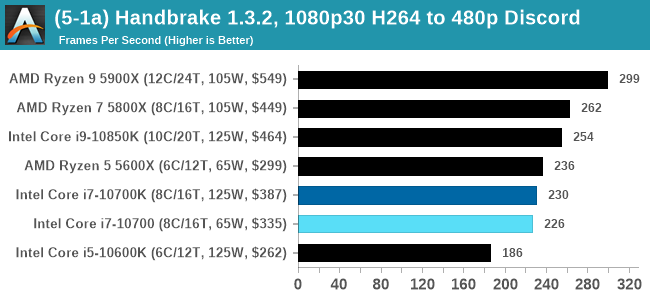

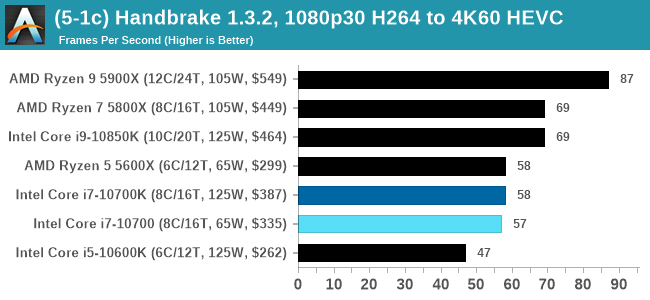
7-Zip 1900: Link
The first compression benchmark tool we use is the open-source 7-zip, which typically offers good scaling across multiple cores. 7-zip is the compression tool most cited by readers as one they would rather see benchmarks on, and the program includes a built-in benchmark tool for both compression and decompression.
The tool can either be run from inside the software or through the command line. We take the latter route as it is easier to automate, obtain results, and put through our process. The command line flags available offer an option for repeated runs, and the output provides the average automatically through the console. We direct this output into a text file and regex the required values for compression, decompression, and a combined score.
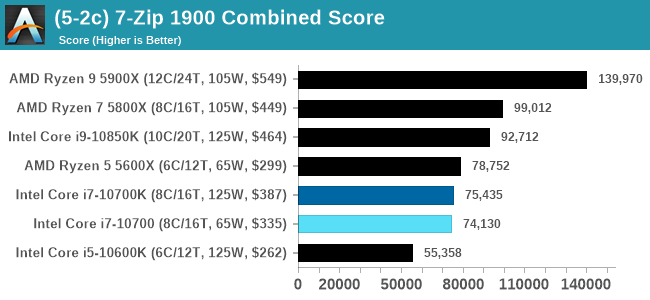
AES Encoding
Algorithms using AES coding have spread far and wide as a ubiquitous tool for encryption. Again, this is another CPU limited test, and modern CPUs have special AES pathways to accelerate their performance. We often see scaling in both frequency and cores with this benchmark. We use the latest version of TrueCrypt and run its benchmark mode over 1GB of in-DRAM data. Results shown are the GB/s average of encryption and decryption.
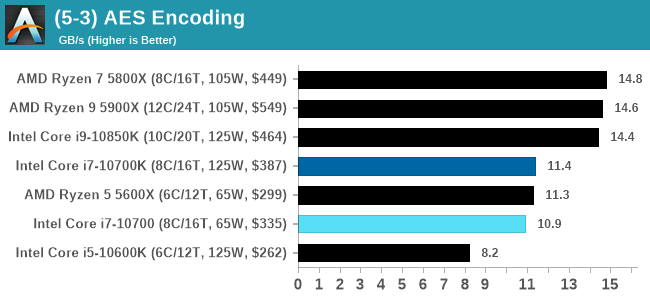
WinRAR 5.90: Link
For the 2020 test suite, we move to the latest version of WinRAR in our compression test. WinRAR in some quarters is more user friendly that 7-Zip, hence its inclusion. Rather than use a benchmark mode as we did with 7-Zip, here we take a set of files representative of a generic stack
- 33 video files , each 30 seconds, in 1.37 GB,
- 2834 smaller website files in 370 folders in 150 MB,
- 100 Beat Saber music tracks and input files, for 451 MB
This is a mixture of compressible and incompressible formats. The results shown are the time taken to encode the file. Due to DRAM caching, we run the test for 20 minutes times and take the average of the last five runs when the benchmark is in a steady state.
For automation, we use AHK’s internal timing tools from initiating the workload until the window closes signifying the end. This means the results are contained within AHK, with an average of the last 5 results being easy enough to calculate.
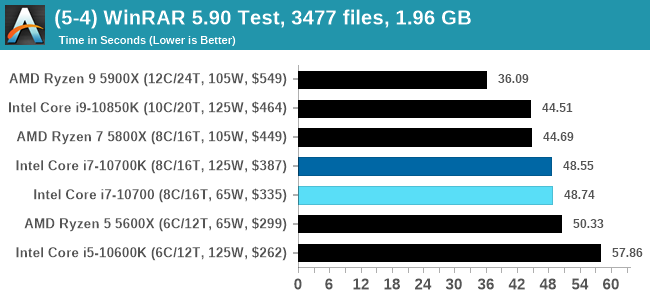


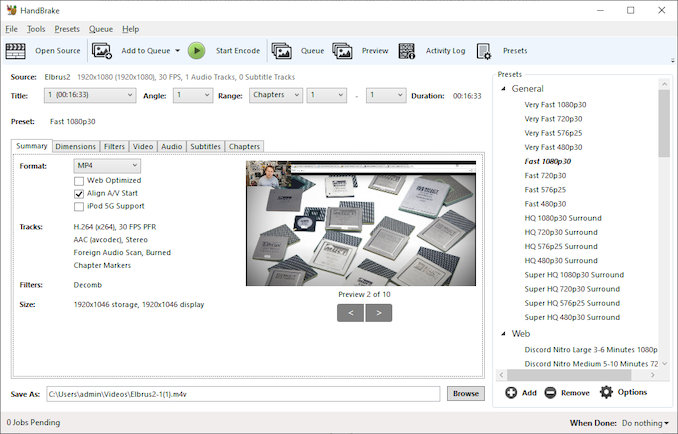
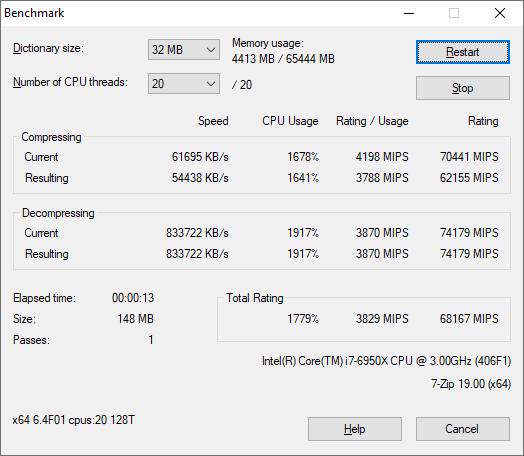









210 Comments
View All Comments
bji - Tuesday, January 26, 2021 - link
Well I guess it's a difference of opinion about what "general availability" means. If most people who are not within direct driving distance of a MicroCenter are having a hard time finding these chips, then I would call that not "general availability". I did admit that I overstated the low number of people who are in driving distance to a MicroCenter, but I still contend that it's a low number relative to the total number of people who want to buy these chips. We could start arguing now about who is TRULY within reasonable driving distance of a MicroCenter -- if you have to drive 1 hour to get the chip, is it really still generally available? If your time is even worth $15/hr minimum wage, that's adding a significant cost in the dollar value of your time to the cost.But I really don't want to argue about it any more. I still think these chips are not generally available and posting an article that compares one to to another when one or both are not easy to get for the vast majority of people, is disingenuous as it presents choices that do not practically exist. If you disagree, then that's fine.
Spunjji - Wednesday, January 27, 2021 - link
It's not a difference of opinion, it's a difference in perspective. I don't even care about MicroCenter because I'm not from the USA. These chips have "general availability" in the EU and UK at the very least, so I appreciate the comparison - as will many other peopleThis article will be around longer than demand continues to outstrip supply in the USA, and maybe even long enough to see $15 an hour become the minimum wage there. 👍
brucethemoose - Thursday, January 21, 2021 - link
Maybe they'll go the route of GPUs and just stop advertising TDPs entirely?This whole system works because most desktop users don't seem to care about TDP or power consumption. Performance at the absolute extreme end of the frequency/voltage curve is all that seems to matter.
Mr_Spock - Thursday, January 21, 2021 - link
I appreciate the testing, showing that with most other things 'equal', there is effectively little difference between the 10700/K.Would you consider running any tests with a 65W-class cooler to demonstrate exactly how performance is damaged by only matching the TDP on the box?
Having the full-bore tests for 10700 is quite useful if you can't find the K at a decent price, but if we're talking about quoted TDP 'limits', let's try limiting to that heat dissipation and see how quickly it flops.
I built a few Haswell systems back in the day, and whoo boy, were those stock coolers ineffective if you got any decent chip under it.
DominionSeraph - Thursday, January 21, 2021 - link
Eh? The stock cooler on the 4770 was fine. They only pulled 50W. I have no idea what you mean by "any decent chip under it" since there was only the 4770 and 4790 at the top and their wattage was about the same. (my 4790 was undervolted a tad and was 50W)Mr_Spock - Thursday, January 21, 2021 - link
Running prime95 on a stock cooler with a 4770 sent temperatures skyrocketing in my experience (80+C). I might have had too-high standards for cooling, since I always recommended at least a 212 EVO or better when it would fit into the cases we used. My employer used cheap cases that didn't come with an exhaust fan by default - installing 1+ case fans was always a recommendation for anything generating a lot of heat if I could convince the customer how much it was needed.Sounds like our use cases might be different? Or, you might have superior case cooling. All I know is we always had more tolerable temps once dumping the included cooler for something more suited to very heavy work.
vegemeister - Friday, January 22, 2021 - link
80°C is safe. Read the Haswell datasheet. The embedded controller won't even tell you to start spinning up the fan until 80°C idle. https://www.intel.com/content/dam/www/public/us/en...quiq - Sunday, January 24, 2021 - link
now using a 4590 whit aftermarket cooler ambient temperature now is 34°C/93°Fhttps://ibb.co/NKYXx6T
I have to upgrade because whit the itb heatsink run over 60°C/140°F all the time
geokilla - Thursday, January 21, 2021 - link
One reason to go for the K series is for faster RAM and the possibility of overclocking it to 5GHz. Shame there's no overclocking vs turbo results.Naine - Thursday, January 21, 2021 - link
You keep talking about how the TDP means nothing in the context of peak power draw, but it has nothing to do with peak power draw. That is only restricted by PL2, which is probably well over 200W for that chip, and like you say, motherboards can come up with their own PL2 values, especially if you slot this into the same high-end Z490 board you bought for your K CPU. Different story if you put it in a low-end B460 board.Here's what "65W TDP" means: If you pair this CPU with a 65W cooler, it will work.
That's literally what it means.